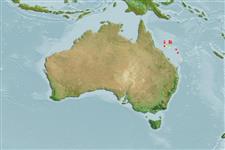Common names from other countries
Elasmobranchii (hajar och rockor) (sharks and rays) >
Rajiformes (Skates and rays) >
Anacanthobatidae (Smooth skates)
Etymology: filicauda: Name from Latin ‘filum’ meaning thread and ‘cauda’ for tail or appendage, referring to its thread-like tail tip..
More on authors: Last & Séret.
Environment: milieu / climate zone / depth range / distribution range
Ekologi
marina djupbottenlevande; djupintervall 606 - 880 m (Ref. 75174). Tropical; 17°S - 25°S, 149°E - 156°E (Ref. 75174)
Western Pacific: (Queensland) Australia, possibly more widespread in Northern Coral Sea (Refs. 75174, 114953).
Size / Vikt / Age
Maturity: Lm ? range ? - ? cm
Max length : 55.0 cm TL hane/ej könsbestämd; (Ref. 75174)
Short description
Bestämningsnycklar | Morfologi | Morfometri
This species is distinguished by the following set of characters:: disc large, width at anterior orbit 5.7-8.1 times mouth width; tail short, postcloacal length 97-140% of disc length; eyes relatively large, orbit diameter 7.1-9.6 in horizontal snout and 9.4-11.3 in head lengths respectively; distal portion of tail not expanded, width of tail near tip 0.7-1.1 times tail width at its midlength; pectoral-fin radials 71-75; pelvic fins moderate-sized, anterior lobe 14.8-16.2% TL; anterior pelvic-fin lobe rather broad-based, width 1.6-2.5 in distance between pelvic-fin origins; caudal fin rudimentary; tooth rows in each jaw of adults 18-22; teeth of adult males with very short cusps; monospondylous vertebral centra 27-30, total centra 155-182; dorsal surface uniformly pale pinkish brown, ventral surface pale, translucent (Ref. 75174).
Life cycle and mating behavior
Maturities | Reproduktion | Spawnings | Egg(s) | Fecundities | Larver
Last, P.R. and B. Séret, 2008. Three new legskates of the genus Sinobatis (Rajoidei: Anacanthobatidae) from the Indo-West Pacific. Zootaxa 1671:33-58. (Ref. 75174)
IUCN Red List Status (Ref. 130435)
CITES (Ref. 128078)
Not Evaluated
Threat to humans
Harmless
Human uses
Verktyg
Special reports
Download XML
Internet-källor
Estimates based on models
Preferred temperature (Ref.
115969): 5.5 - 8.2, mean 6.3 (based on 7 cells).
Phylogenetic diversity index (Ref.
82804): PD
50 = 0.5020 [Uniqueness, from 0.5 = low to 2.0 = high].
Bayesian length-weight: a=0.01000 (0.00244 - 0.04107), b=3.04 (2.81 - 3.27), in cm Total Length, based on all LWR estimates for this body shape (Ref.
93245).
Trofisk nivå (Ref.
69278): 3.8 ±0.6 se; based on size and trophs of closest relatives
Fishing Vulnerability (Ref.
59153): Moderate vulnerability (42 of 100).
